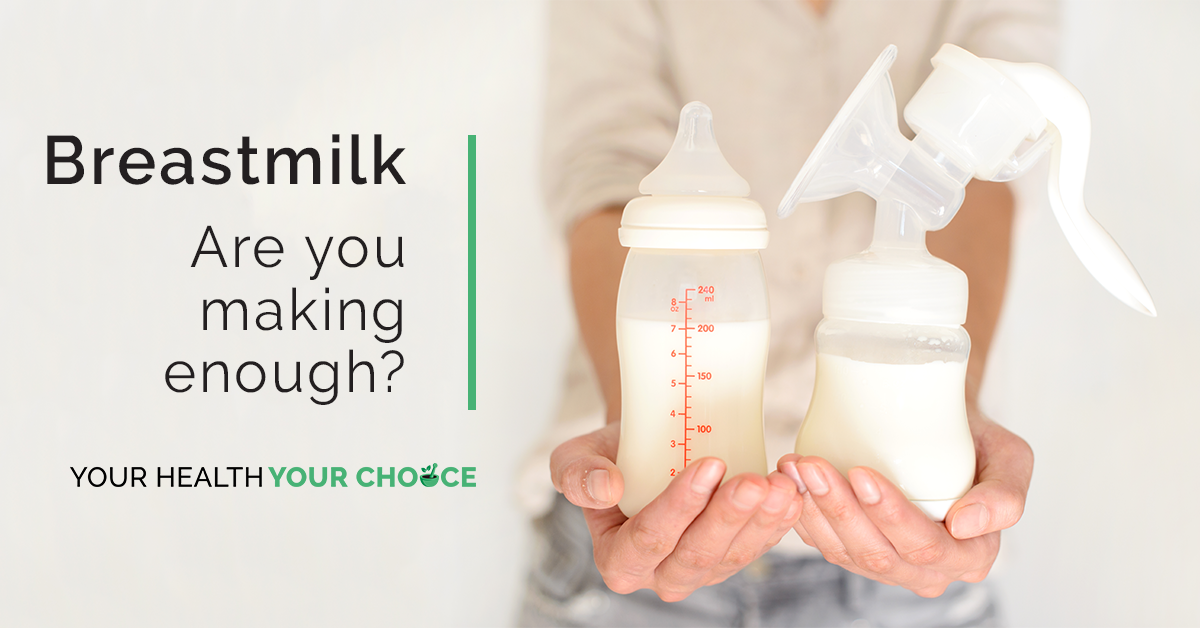Breastmilk – are you producing enough?

Breast milk is produced simply because of demand. As baby feeds from the breast, or the milk is expressed when the breast is pumped, a feedback system signals the mother’s body to make more milk. The more frequently the breasts are emptied, the faster they will regulate to produce more milk. When baby is born, it is recommended to breastfeed or express at least every two to three hours around the clock.
Two key hormones involved in this process are prolactin – which promotes milk production, and oxytocin – which promotes milk ‘let-down’ or flow of the milk to the baby.
Prolactin – the driver
In the first few days after the birth of your baby, prolactin is responsible for the tremendous surge in your milk supply that often causes breast engorgement as your colostrum changes over to transitional breast milk. Prolactin levels will go down if breast feeding or pumping is discontinued, and milk production will cease. The more often the breasts are stimulated, the more the brain will release prolactin.
What causes low supply?
Keeping in mind that most women do have a sufficient milk supply, and concerns of inadequate milk are mostly unwarranted, there may be circumstances that precipitate low prolactin levels and reduced milk supply. Some examples are:
Always seek the help of a professional if you are concerned. There are a range of factors, including mother’s and baby’s health, baby’s sucking skills, proper latch and frequency of feeds, which can also affect milk production.
Brisbane homeopath and lactation consultant, Patricia Hatherly, outlines in her book The Homoeopathic Physician’s Guide to Lactation, that all babies experience “growth spurts” where the supply becomes inadequate. She recommends that feeding on demand for 24-48 hours the breasts are then sufficiently stimulated to increase the supply up to the required level.
Hatherly also stipulates that it is important to be well-rested to ensure a good let-down reflex, consume adequate fluids, and eat a nutritious diet with adequate protein intake which will ensure sufficient “building blocks” to facilitate milk production. Her book also outlines the benefit of individualised homeopathic support of both mother and baby to augment the dietary approach.
The wonderful world of galactagogues
Almost every culture has some sort of herb, plant or remedy to increase milk supply. While exclusive breast feeding and boosting feeds is the most effective way to increase supply, galactagogues (breastmilk promoting substances) may have their place also, particularly when there are other factors that may decrease supply and you need some extra assistance, such as, when you are:
Galactagogue use is common in Australia with approximately 60% of breastfeeding mothers use one or more galactagogues to increase supply. These include lactation cookies (47%), brewer’s yeast (32%), fenugreek (22%) and the prescription medicine domperidone (19%). Over 23% of domperidone users reported experiencing multiple side effects, compared to an average of 3% of women taking herbal galactagogues, which were self-prescribed.
Natural solutions
A population study in Western Australia shows the most used herbal galactagogues are fenugreek (18.4%), ginger (11.8%), dong quai (7.9%), chamomile (7.2%), garlic (6.6%) and blessed thistle (5.9%).
Fenugreek (Trigonella foenum-graecum L.) is a member of the pea family sometimes used in artificial maple flavoring. Fenugreek has been used for many years to promote wellness, increase milk supply and to help with urethritis (urethral inflammation) and arthritis (joint inflammation). It has been used for many years in Indian and Chinese cooking.
One systematic review shows that fenugreek significantly increased amount of the produced breast milk versus placebo. However, the effect of fenugreek was substantially inferior to palm date, an ancient galactagogue.
It is estimated that 100g of dates can provide upwards of 300 kcal and contain over 10 different essential minerals such as selenium, zinc, copper, potassium and magnesium. They contain B-complex vitamins, vitamin C and are high in fibre. Palm dates also have antioxidant properties.
One study looked at 25 women who ate the flesh of 10 grade A palm dates 3 times a day and were found to have increased breast milk production. This was most noticeable in the first two-weeks postpartum. Breast milk volume almost doubled in the date-eating group as compared to the control group.
How to tell is baby is getting enough
The best way to tell if your baby is getting enough milk is to keep track of wet and dirty nappies. Mother’s milk changes which is reflected in baby’s stools. Over the first two weeks baby’s stools will change from black and tarry, to greenish/yellowish, then becoming yellow, loose, and seedy. Around 10-15 days after delivery, baby may pass stool after every feeding or less often.
Here are other signs that your baby is getting enough milk:
Seek professional advice
While it is safe to consume foods that are known to increase breast milk, it is important to work with a professional to ascertain which herbs may work the best for your situation and in conjunction with any health other conditions you may have. They can also advise you on how much of each herb you should take and whether it is safe for baby. There is the chance of side effects if not used correctly. This is an area that would benefit from further research, which is currently quite minimal considering the popularity of herbal preparations that are often self-prescribed.
« Return to News & Features
